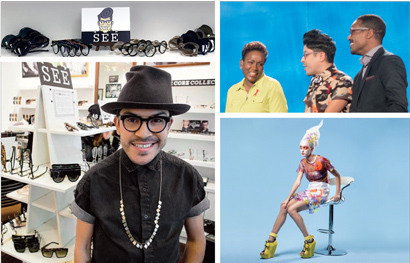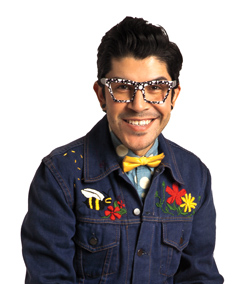 |
| Clockwise from bottom left: Mondo Guerra poses with his See eyewear collection; additional eyewear from the collection; a panel discussion with fellow “I Design” HIV/AIDS media campaign spokespeople Maria Davis and Duane Cramer; fashion created by Mondo. |
Mondo Guerra is a fashion designer who first came to fame in 2010 as a contestant on the eighth season of the reality television show Project Runway. Although he didn’t win, Guerra was a fan favorite, even before he disclosed his HIV-positive status on the show. At that moment he also took on the role of HIV/AIDS activist.
Guerra went through a whirlwind of media attention, including appearing on the December 2010 cover of POZ as a member of our POZ 100 list. Since then, his celebrity profile has certainly increased. He won the debut season of Project Runway All Stars and became a mentor on Under the Gunn (a spinoff series named after Project Runway host Tim Gunn). His designs include apparel, accessories and jewelry.
Guerra also has found a way to connect his design career with his advocacy. He is a spokesperson for “I Design,” an HIV/AIDS media campaign sponsored by Merck. He also is a spokesperson for “Dining Out for Life,” an annual fundraiser sponsored by Subaru, in which restaurants donate proceeds to local HIV/AIDS groups. Five years after publicly disclosing he has HIV, Guerra explains how his life has changed and shares his goals for the future.
What prompted you to get tested for the virus in 2001 at the age of 22?
When I was younger, I believed, like every young person, that I was invincible. I was not making the best decisions. I could feel there was something different about me. So I got tested, and my test came back positive.
After the diagnosis, I was devastated. I grew up in a Latino household and community, and there was never any discussion about HIV/AIDS, so it was definitely scary to me. I did not know how to deal with it.
When I was newly diagnosed, I was very ashamed and afraid. I didn’t really seek any support. I hate to say this, but in a lot of ways, looking back now, being raised Roman Catholic, I felt like it was some kind of punishment.
I stayed silent about my positive status even up to when I was in the hospital with pneumonia over Christmas in 2009. With my family and friends visiting me, I asked my doctors not to disclose any information.
They were walking into a room with a bed where I was hooked up to this and that, and in my heart and mind I was dying of AIDS. I still didn’t talk about it. I hit rock bottom, and I knew I had to start taking better care of myself.
I started taking medical advice and the proper treatments that I needed, and I got better very quickly. I had goals. For such a long time before I was in the hospital, HIV was defining who I was as a person and also as a creative.
The creative part of me was dying, so I had no reason to live. This creativity, the outlets where I was able to express myself, I used them to escape, a way to get through the day. This emotional and spiritual support is an important part of keeping me going.
Tell us about your decision to disclose on Project Runway in 2010.
My revelation on Project Runway was life-changing. It came from fear and turned into a huge sense of responsibility. I walked out on that runway in such a mood, but two hours later I was like, “What are people going to say?”
I was completely scared, so it wasn’t until four days before the episode aired that I told my parents. My parents still live in the home that I grew up in. At the dinner table, we have assigned seating that has never changed.
We had dinner. I knew in my heart—which was beating a million miles an hour—that I just had to come out with it, so I told my parents. “I know” was the first thing my mom told me, that motherly instinct I have always heard about. We talked some more, then my mom said, “I am proud of you.”
That helped me to talk about HIV/AIDS more. I get very emotional about it still because I felt the love that came from the table that night, and it hurts me still because I didn’t trust them and that made me feel bad.
Speaking of your family, your mom and aunts inspired some of your eyewear.
My eyewear collection is inspired by family and friends. There is a whole set of eyewear that is named after my mom and her sisters. It is my way to give back to them, because they have been so supportive and inspirational. It is the least I can do.
I’ve had the great opportunity to have a reality show competition pivot me into some visibility for my designs. It has been such a blessing to have a crossover between my creative work and my advocacy.
Any collaboration that I do at this point must have some kind of way to give back. So I’m glad that part of the See eyewear proceeds goes to amfAR, The Foundation for AIDS Research. It just makes sense to me to be able to do that for others.
What’s new this year with the ongoing I Design campaign?
This is my fourth year with I Design and my fifth with Merck. This year is important to me because it is focusing on how you are feeling—having an open conversation with your doctor and your health care team.
In addition to having my HIV doctor and my other health care providers, I also feel like my family has become part of my health care team. I share things with them, and they share with me—they ask, “Have you heard about this?” and, “Have you asked your doctor about this?”
If I had been able to allow others to be involved in my journey from the beginning, I would not have allowed myself to get to the point where I was in the hospital. Without my health, I am not able to continue being productive. Tell us about Dining Out for Life.
Tell us about Dining Out for Life.
Dining Out for Life is special to me. I started going when I stumbled on it one April about a decade ago. It is always something I look forward to, taking someone to a participating restaurant to have dinner and talk about life, knowing that we are helping a good cause.
After my collaborations with I Design and my other advocacy work, the Dining Out for Life organizers approached me, figuring I would be a good fit. I felt like it was going to be a great fit because I’m a huge foodie and I love to eat.
My favorite cuisine is French food. I love to cook. I am more of a savory guy rather than a sweet guy. I have a really fun time on this campaign. I get to travel and I get to meet people, just like with my other work.
You’re also doing speaking gigs now. Why does that appeal to you?
I think it’s a good fit for me because I am pretty approachable. In my private life I am kind of an introvert, but I do put myself out there to be like an open book. To speak to college students is important to me because that is around the time that I was diagnosed.
I try to make it like Inside the Actors Studio, because I want to make it feel like someone is just sitting down with me to talk. I want students to be comfortable to raise their hands and ask questions. I am not there to lecture anyone. I am only there to share my story and the importance of using your voice and story as a tool. Your story can open up a conversation.
At first, I was afraid to get up on stage for these talks because, as a person living with HIV, I was afraid they would be judging me. That was scary for me, but that fear had to go away at some point because it weighed me down so much. You have to let go.
What’s next for you?
Right now, I am focusing on restructuring my business. I would love to focus more on my fashion. Advocacy remains dear to me, so I would like more ways to do this crossover of my interests.
I am working on a new show where I am allowed to communicate about HIV and my creative work. I’m not very sure on the direction of it, but it’s important for me to give inspiration and information to young people.






2 Comments
2 Comments